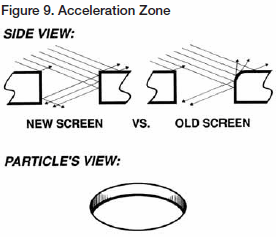High Speed Hammermills For Fine Grinding: Part 4 - Hammers, Screens

Hammers
There are an unlimited number of hammer styles available from many suppliers around the world. At the same time, there are distinctly different types of hammers used in different regions of the world for a variety of hammermill grinding tasks. For longest hammer life and most efficient operation, a hammer with a flared hardface end (or ends) is preferred. Hammers may be one hole, with one working end (two corners) or two holed, with four corners available for grinding. One hole hammers are generally preferred to maintain balance of the rotor and minimize the potential for catastrophic hammer failure (Figure 5).
Hammer patterns (the number and distribution of the hammers on the rotor) and positions (setting the hammer closer to or further from the screen) have a profound effect on the performance of any hammermill. Because different materials grind differently, the ideal number of hammers and clearance to the screen will need to be adjusted according to each application.
It is important to make sure the hammer pattern covers the working screen, without having hammers trailing hammers in line. In most cases, the hammer pattern should include double hammers on the outside rolls of at least two opposing pins. This is because the material in the grinding chamber near the sides of the mill moves more slowly than material in the middle of the mill due to friction on the sides, consequently the outside rows of hammers must do more work and are subject to more wear (Figure 6).
Most general application hammermills today are equipped with a rotor designed for a 4 pin hammer pattern or a 6 pin hammer pattern. Since the rotors are normally drilled for two hammer positions (coarse and fine) the rotors are actually fit with 8 or 12 sets of hammer pins. For fine grinding applications it is often necessary to use an extra heavy hammer pattern to achieve the very fine finished products desired: in many cases, the rotor will be equipped with hammers on all 8 or all 12 sets of hammer pins. This way the total number of hammers is increased significantly, without putting an excessive number of hammers on any individual pin(s), which could lead to high stress and the possible failure of the pins or rotor plates (Figures 7 and 8).
To insure the motor can start a machine with a high inertial load, an electronic soft start may be required.

Screens
In terms of hammermill capacity and efficiency, the best screen for any job is the thinnest material with the most open area. Naturally, some sacrifice in efficiency must be made for the sake of endurance, yet the general rule applies. On the other hand, for many aquaculture applications there is a benefit to using screens with limited open area to promote a finer finished product. Indeed, many hammermills grinding in aquaculture applications are equipped with extended wear liners at the inlet of the machine to increase the impact and grinding that occurs when the product is first struck by the hammers. Some users go so far as to "blank off" a portion of the down side screen by placing a solid sheet metal plate behind the screen to prevent material from passing through the screen openings. This promotes finer finished products, although the production rate will be negatively impacted (Figure 9).
Factors effecting open area include hole size, stagger, angle of stagger, and hole spacing. There are a few specialty screens being used in aquaculture applications to improve the grinding performance. One type of screen material is known as the "Conidur" with the holes punched is such a way that the surface is upset, almost like small louvers or the surface of a cheese grater. This type of screen can work effectively, but is very expensive to purchase and will reduce the machine capacity. One reason the "Conidur" type screen produces a finer finished product is the fact the open area is very low when compared to a conventional round hole screen with a similar opening diameter.
Sealing at the edges of the screen is particularly important when fine grinding for aquaculture feeds. The fit of the screen carriage and the wear liner must be precise to prevent any oversize particles from bypassing around the edges of the screen. At the same time, the screen must be adequately supported, as fine screens do not have the mechanical strength of thicker, heavier screen material. Regular inspections of the screens must be made to monitor the condition of the screens and to catch any worn or failing screens before they fail completely.
High Speed Hammermills For Fine Grinding: Part 2 - Equipment Description, Basic Machine Characteristics
High Speed Hammermills For Fine Grinding: Part 3 - Basic Operational Concepts, Tip Speed
High Speed Hammermills For Fine Grinding: Part 5 - Feeders, Air Assist
High Speed Hammermills For Fine Grinding: Part 6 - Other Considerations




